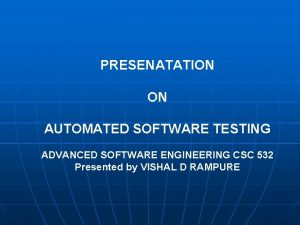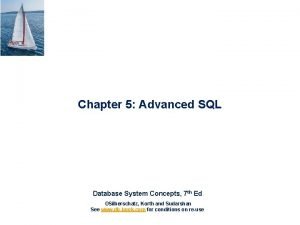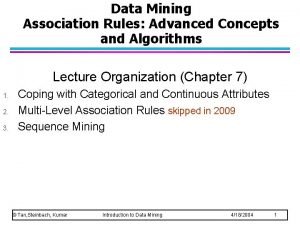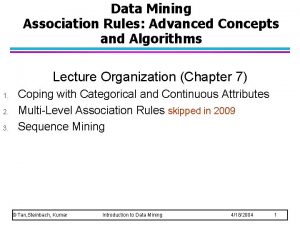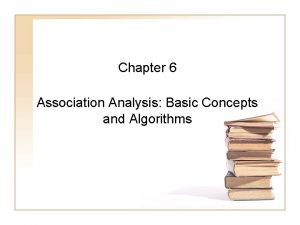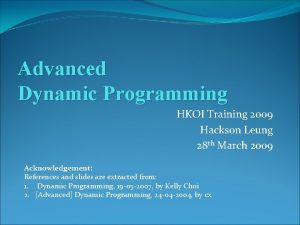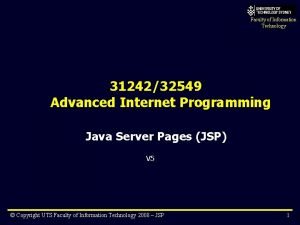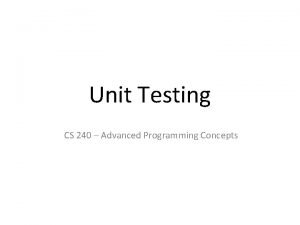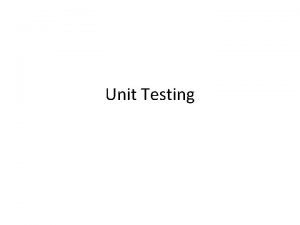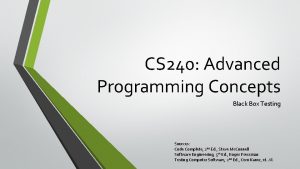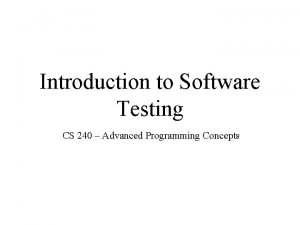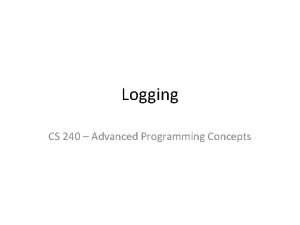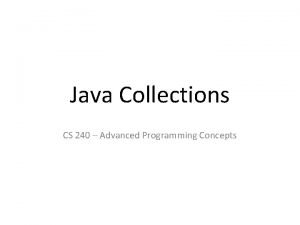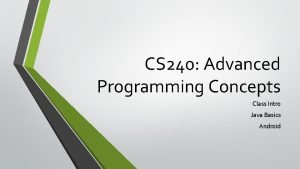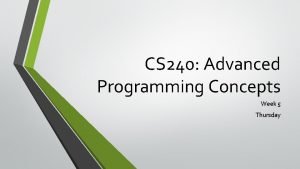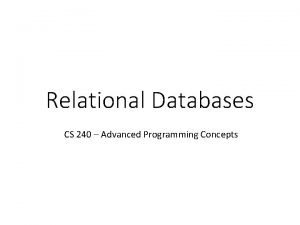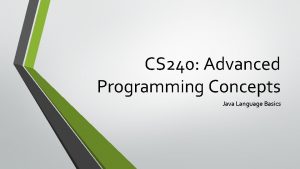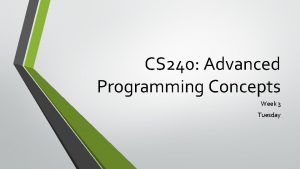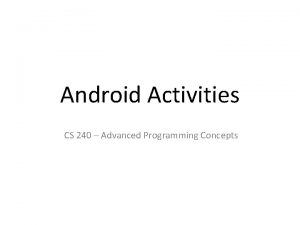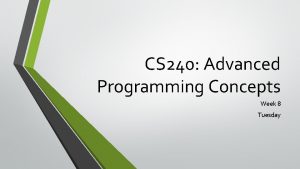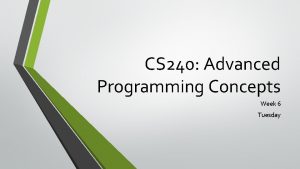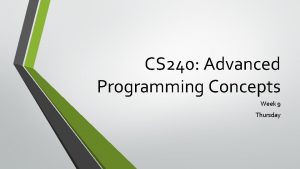Unit Testing CS 240 Advanced Programming Concepts F22



















- Slides: 19

Unit Testing CS 240 – Advanced Programming Concepts

F-22 Raptor Fighter 2

F-22 Raptor Fighter • Manufactured by Lockheed Martin & Boeing • How many parts does the F-22 have? 3

F-22 Raptor Fighter • What would happen if Lockheed assembled an F 22 with "untested" parts (i. e. , parts that were built but never verified)? • It wouldn't work, and you probably would never be able to make it work – Cheaper and easier to just start over 4

Managing Implementation Complexity • Individual parts should be verified before being integrated with other parts • Integrated subsystems should also be verified • If adding a new part breaks the system, the problem must be related to the recently added part • Track down the problem and fix it • This ultimately leads to a complete system that works 5

2 Approaches to Programming • Approach #1 – "I wrote ALL of the code, but when I tried to compile and run it, nothing seemed to work!“ • Approach #2 – Write a little code (e. g. , a method or small class) – Test it – Write a little more code – Test it – Integrate the two verified pieces of code – Test it –… 6

Unit Testing • Large programs consist of many smaller pieces – Classes, methods, packages, etc. • "Unit" is a generic term for these smaller pieces • Three important types of software testing are: – Unit Testing (test units in isolation) – Integration Testing (test integrated units) – System Testing (test entire system that is fully integrated) • Unit Testing is done to test the smaller pieces in isolation before they are combined with other pieces – Usually done by the developers who write the code 7

What Unit Tests Do • Unit tests create objects, call methods, and verify that the returned results are correct • Actual results vs. Expected results • Unit tests should be automated so they can be run frequently (many times a day) to ensure that changes, additions, bug fixes, etc. have not broken the code – Regression testing • Notifies you when changes have introduced bugs, and helps to avoid destabilizing the system 8

Test Driver Program • The tests are run by a "test driver", which is a program that just runs all of the unit test cases • It must be easy to add new tests to the test driver • After running the test cases, the test driver either tells you that everything worked, or gives you a list of tests that failed • Little or no manual labor required to run tests and check the results 9

JUnit Testing Design • Write a separate test method for each test – Marked with @Test annotation • Set up method(s) may be executed before each test method – Marked with @Before. Each or @Before. All • Tear down method(s) may executed after each test – Marked with @After. Each or @After. All • Use JUnit Assertions. assert*() methods to implement test cases • Failures reported in various ways, depending on language and tool (command-line, GUI, IDE integrated) • Example: – Word. Extractor. java – Word. Extractor. Test. java 10

Running Junit Tests from Intellij and Android Studio • To run a single test class, in the “Project” tool window right-click on a test class name, and select “Run Tests” or “Debug Tests” • To run all of your unit tests, right-click on the “test/java” folder, and select “Run All Tests” or “Debug All Tests” 11

Running Unit Tests from The Command-Line • Write a test driver class whose “main” method invokes the org. junit. runner. JUnit. Core class to run your unit tests • Run your test driver program from the command-line: java –cp buildclassesmain; buildclassestest; libsjunit-jupiter -api-5. 5. 1. jar; libsjunit-platform-console-1. 5. 1. jar; libssqlitejdbc-3. 25. 2. jar Test. Driver 12

JUnit 5 Unit Testing Framework • JUnit 5 Documentation • Use JUnit 5 annotations to mark test methods Annotation Description @Test public void method() The annotation @Test identifies that a method is a test method. @Before. Each public void method() Will execute the method before each test. Can prepare the test environment (e. g. read input data, initialize the class). @After. Each public void method() Will execute the method after each test. Can cleanup the test environment (e. g. delete temporary data, restore defaults). 13

JUnit 5 Unit Testing Framework Annotation Description @Before. All public void method() Will execute the method once, before the start of all tests. Can be used to perform time intensive activities, for example to connect to a database. @After. All public void method() @Timeout(5) @Timeout(value = 100, unit = Time. Unit. MILLISECONDS) Will execute the method once, after all tests have finished. Can be used to perform clean-up activities, for example to disconnect from a database. Fails if the method takes longer than 5 seconds. Fails if the method takes longer than 100 milliseconds 14

Adding the JUnit Library to Your Project • Maven <dependency> <group. Id>org. junit. jupiter</group. Id> <artifact. Id>junit-jupiter-api</artifact. Id> <version>5. 5. 1</version> <scope>test</scope> </dependency> • Gradle (build. gradle file) test. Compile group: 'org. junit. jupiter', name: 'junit -jupiter-api', version: '5. 5. 1' 15

A More Detailed Example • code-example on website in the unit testing lecture notes • Contains code for web-based spelling checker • “Real” classes are in: – src/main/java/spellcheck/*. java – src/main/java/dataaccess/*. java • “Test” classes are in: – src/test/java/spellcheck/*. java – src/test/java/dataaccess/*. java 16

Android Testing Framework • Android provides a framework for writing automated unit tests based on Junit • There are two types of Android unit tests – Local Unit Tests • These tests depend only on standard Java classes and can be ran on the development computer instead of on an Android device • You will create local unit tests for the Family Map Server project – Instrumented Unit Tests • These tests depend on Android-specific classes and must be run on an Android device • You will create instrumented unit tests for the Family Map Client project 17

Android Local Unit Tests • Official Documentation • Can run on the development computer without a device or emulator • Module’s primary source code is located in the folder – <module>/src/main/java/<package> • Local unit test code is located in the folder – <module>/src/test/java/<package> 18

Database Unit Tests • When writing unit tests for your database code, there additional things to think about • Put database driver JAR file on the class path • Each unit test should start with a pristine database so prior tests have no effect – Can re-create tables before each test – Or, you can “rollback” the effects of each test so they are undone and don’t affect later tests 19
 Advanced software testing concepts
Advanced software testing concepts F22 raptor exhaust
F22 raptor exhaust Chem
Chem Neighborhood integration testing
Neighborhood integration testing Higher music concepts
Higher music concepts Php advanced concepts
Php advanced concepts Association analysis advanced concepts
Association analysis advanced concepts Advanced sql concepts
Advanced sql concepts Chapter 9 kumar steinbach tan
Chapter 9 kumar steinbach tan Association analysis advanced concepts
Association analysis advanced concepts Association analysis advanced concepts
Association analysis advanced concepts Association analysis advanced concepts
Association analysis advanced concepts Association analysis advanced concepts
Association analysis advanced concepts Subset operation using hash tree
Subset operation using hash tree Advanced dynamic programming
Advanced dynamic programming Advanced internet programming
Advanced internet programming Synthesis phase of assembler
Synthesis phase of assembler Language processor
Language processor Advanced programming in java
Advanced programming in java Uiuc cs 527
Uiuc cs 527
